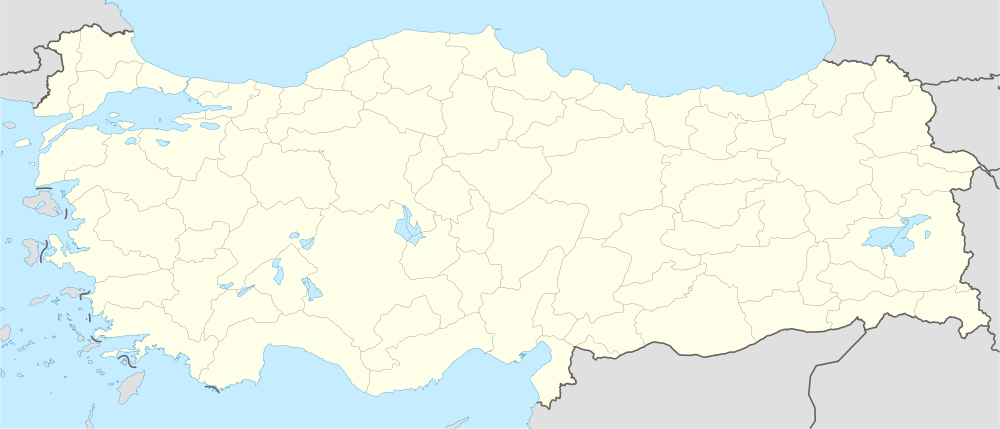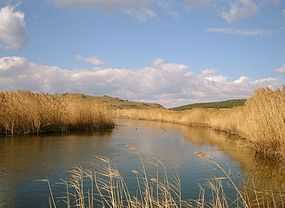Myrina (Aeolis)
| Myrina | |
|---|---|
| Μυρίνα (Ancient Greek) | |
|
Ancient Myrina was located on the Beriki Tepe hill, on the left bank of the Pytikos River. | |
 Shown within Turkey | |
| Location | Aliağa, Izmir Province, Turkey |
| Region | Mysia |
| Coordinates | 38°50′43″N 26°59′4″E / 38.84528°N 26.98444°ECoordinates: 38°50′43″N 26°59′4″E / 38.84528°N 26.98444°E |
| Type | Settlement |
| History | |
| Associated with | Agathias |
Myrina (Ancient Greek: Μυρίνα), was one of the Aeolian cities on the western coast of Mysia, about 40 stadia to the southwest of Gryneion.[1] Its site is believed to be occupied by the modern Sandarlik at the mouth of the Koca Çay.[2]
History

_enano_de_terracota.png)
It is said to have been founded by one Myrinus before the other Aeolian cities,[3] or by the Amazon Myrina.[4] Artaxerxes gave Gryneium and Myrina to Gongylus, an Eretrian, who had been banished from his native city for favoring the interests of Persia.[5]
Myrina was a very strong place,[6] though not very large, and had a good harbor.[7] Pliny[8] mentions the fame of its oysters and that it bore the surname of Sebastopolis; while, according to Syncellus, it was also called Smyrna. An inscription (Bulletin de correspondance hellenique, V, 283) tells us that Myrina formed part of the Kingdom of Pergamon in the 3rd century BC. For some time Myrina was occupied by Philip V of Macedon; but the Romans compelled him to evacuate it, and declared the place free.[9] It twice suffered severe earthquakes; first in the reign of Tiberius,[10] on which occasion it received a remission of duties on account of the loss it had sustained; and a second time in the reign of Trajan.[11] The town was restored each time, and continued to exist until a late period.[12] It was the birthplace of Agathias, a Byzantine poet and historian of the 6th century. Myrina minted coins in antiquity, some of which survive.
Under Roman rule, Myrina was part of the Roman province of Asia and its bishopric was a suffragan of the metropolitan see of Ephesus. The names of some of its bishops are known: Dorotheus, 431; Proterius, 451; John, 553; Cosmas, 787.[13] It still existed as a residential see in the 14th century, but is now included in the Catholic Church's list of titular sees.[14]
The site of Myrina was discovered at the mouth of the river that was the ancient Pythicos, whose alluvia have covered what was the city's harbour. Excavations (1880-1882) brought to light about four thousand tombs, dating from the last two centuries BC, in which were found numerous objects representing the divinities of the Greek pantheon; children's toys, reproductions of famous works, etc.: most of these may be seen today in the Museum of the Louvre.
Famous residents
References
 This article incorporates text from a publication now in the public domain: Smith, William, ed. (1854–1857). "article name needed". Dictionary of Greek and Roman Geography. London: John Murray.
This article incorporates text from a publication now in the public domain: Smith, William, ed. (1854–1857). "article name needed". Dictionary of Greek and Roman Geography. London: John Murray. Siméon Vailhé (1913). "Myrina". Catholic Encyclopedia. New York: Robert Appleton Company.
Siméon Vailhé (1913). "Myrina". Catholic Encyclopedia. New York: Robert Appleton Company.
- ↑ Herod. i. 149.
- ↑ Richard Talbert, Barrington Atlas of the Greek and Roman World, (ISBN 0-691-03169-X), Map 56 & notes.
- ↑ Mela, i. 18.
- ↑ Strabo xi. p. 505, xii. p. 573, xiii. p. 623; Diod. iii. 54.
- ↑ Xenoph. Hellen. iii. 1. § 4.
- ↑ Liv. xxxiii. 30.
- ↑ Scylax, p. 36; Agath. Praef. p. 9, ed. Bonn.
- ↑ v. 32.
- ↑ Liv. l. c,; Polyb. xviii. 27.
- ↑ Tac. Ann. ii. 47.
- ↑ Oros. vii. 12.
- ↑ Steph. Byz. s. v.; Ptol. v. 2. § 6; Apollon. Rhod. i. 604; Hierocl. p. 661; Geogr. Rav. v. 9, where it is called Myrenna, while in the Peut. Tab. it bears the name Marinna.)
- ↑ Le Quien, "Oriens Christ.", I, 705
- ↑ Annuario Pontificio 2013 (Libreria Editrice Vaticana, 2013, ISBN 978-88-209-9070-1), p. 931
External links
| Wikimedia Commons has media related to Terracotta figurines from Myrina. |
- asiaminorcoins.com, Ancient coins of Myrina
